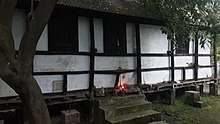Hinduism in Meghalaya
Hinduism is a minority religion in the Meghalaya state of India. Hindus constitute 12% of the population. Hinduism is a popular religion practice by Rabhas, Hajongs, Kochs, Rajbongshis, Mikirs, Bengalis, Nepalis, Biharis etc.

Tradition

Festivals
Hinduism is practiced by different groups of Meghalaya. Hindus celebrate many festivals in Meghalya.[1] Diwali, Behdienkhlam, Navaratri, etc. are celebrated by people. Navaratri and other Goddess Pujas are celebrated mainly by Bengali people. Diwali is celebrated by almost all Hindus. Behdienkhlam is celebrated by Pnar/Jaintia Hindus with Niamatre believers.[2]

In Jowai, Behdienkhlam is a harvest festival celebrate by Hindus and Niamatre believers. This festival is popular among non-Christian Pnar people(Jaintia).
Other many Hindu festivals celebrate Hindus likeMakar Sankranti,Diwali,Holi,Navaratri,etc.
Important Temples and Shrines
In Meghalaya,there is Shaktipeeth at Jaintia hills in Nartiang. Here,Shakti is worshipped as Jayanti and Bhairava is worshipped as Kamadishwar. There many native Brahmins who caretakes temple and organises ritual programs.According to people,this Shakti peetha is only one on Earth which is abode of Durga[3]
Hajong Tradition
Hajong people practice Hinduism from long time. They worship specific Avatars(equivalent to Hindu deities). Ex.-
- Lakshmi-Lukkhi Dyao
- Vishnu-Bishnu Dyao
- Shiv-Shib Dyao
- Kartikeya-Katka Dyao
Dyao is derived from Sanskrit word- (देव Deva,modern Indian languages- Dev/Deo).
Rabha people
Rabha people's religious world is pervaded with various spirits and natural objects. The main deity of the Rabhas is called Rishi. Rishi, for the forest Rabhas as well as village Rabhas, is a male deity. He is also known as Mahakal. Forest Rabhas worship him in all important social and religious ceremonies.[4]
Demographics
Hindus are mainly found in West Garo Hills district with 19%, East Khasi Hills District with 17.50%, Assam bordering Ri-Bhoi District with 12%. Hinduism is followed by 42% of the population of Shilling.
Percentage in Groups
According to 2011 census there are 342,078 Hindus living in Meghalaya accounting constituting 11.53% of the state population after Christianity. Hinduism is practiced by these following groups:-
- Hajong people (31,381 – 97.23% Hindu),[5]
- Koch people (21,381 – 98.53% Hindu),[6]
- Rajbongshi people [7]
- Rabha tribe (28,153 – 94.60% Hindu),
- Karbi People (Mikir people). (11,399 – 52% Christian and 30% Hindu),
- Nepali people (80-90% Hindus 10-20% Buddhists),
- Bengali people (55% Hindus, 45% Muslims).
- Bihari people (70%-80% Hindus, 20%-30% Muslims)
- Pnar people (Jaintia people).
References
- "Cultural festival of Meghalaya | Vedic Culture". Hindu Scriptures | Vedic lifestyle, Scriptures, Vedas, Upanishads, Itihaas, Smrutis, Sanskrit. 2018-02-18. Retrieved 2020-04-08.
- "Behdienkhlam festival | Culture in Meghalaya | Times of India Travel". timesofindia.indiatimes.com. Retrieved 2020-04-08.
- "Nartiang Durga Temple - Wikipedia". en.m.wikipedia.org. Retrieved 2020-04-08.
- Karlsson 2000, p. 162
- "Hajong Hinduism - Wikipedia". en.m.wikipedia.org. Retrieved 2020-03-09.
- Project, Joshua. "Koch (Hindu traditions) in India". joshuaproject.net. Retrieved 2020-03-09.
- "Rajbongshi people - Wikipedia". en.m.wikipedia.org. Retrieved 2020-03-09.